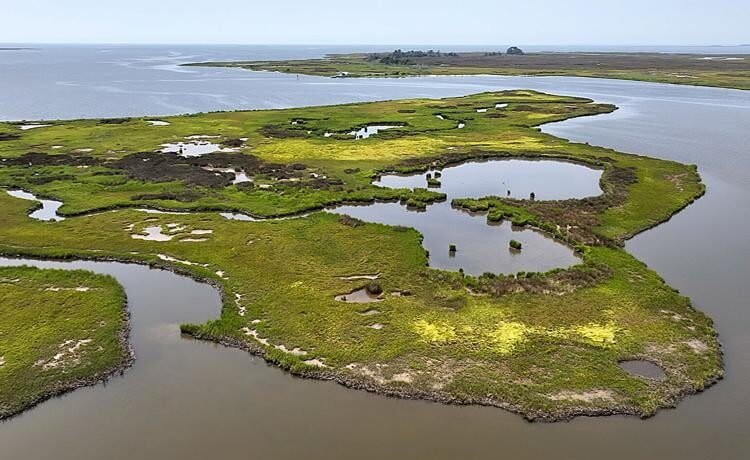
ANNAPOLIS, Md. – As the Chesapeake Bay cleanup’s leaders close in on a revised working agreement, many of the effort’s most influential supporters are endorsing a major thematic shift: putting less emphasis on improving the estuary’s seldom-seen deep waters and more on helping people and living resources in the Bay watershed.
“This is an opportunity for our movement to understand our successes and failures, and adjust accordingly,” said Kate Fritz, CEO of the Alliance for the Chesapeake Bay, in a letter to the Chesapeake Bay Program, the multistate and federal partnership in charge of reviving the Bay. “This means … intentionally including people and living resources at the center of the partnership’s work.”
That closely aligns with the recommendations of the Bay Program team that was tasked with drafting an update of the 2014 Chesapeake Bay Agreement. A draft was released for public feedback on July 1.
The team urged the program to “better incentivize practices that maximize benefits to living resources and people.” This, they argued, could be accomplished largely through actions that target water quality improvements — long the effort’s central focus — but only if local community concerns take precedent.
Sounds like everyone is mostly on the same page, right? Not quite.
More than 80 people and organizations submitted comments on the draft agreement by the Aug. 30 deadline. The Chesapeake Executive Council — the governors of the six watershed states, mayor of the District of Columbia, chair of the Chesapeake Bay Commission and administrator of the Environmental Protection Agency — is set to vote on a final draft during its annual meeting in December.
The revised agreement is intended to serve as a top-line strategy for cleaning up the Bay and its 64,000-square-mile drainage basin beyond 2025, when the deadline for goals in the current agreement expires.
For decades, the partnership has centered its work on reducing nutrient and sediment pollution flowing into the Bay. The main goal has been to shrink the annual “dead zones,” pockets of oxygen-starved water in the estuary’s deepest waters where aquatic creatures struggle to survive.
Despite billions of dollars invested in the effort, pollution reductions have been modest and slow in coming, according to the Bay Program’s own calculations. Some advocates and scientists fear that the cleanup risks falling out of favor with the public if it doesn’t shift toward more visible quests, such as restoring shallow waters along the edge of the Bay and its tributaries.
“Without renewed attention to those things that matter the most to people, we run the risk of leaving potential living resource benefits unaddressed and potentially losing public support for our efforts,” wrote Larry Sanford, chair of the Bay Program’s Scientific and Technical Advisory Committee (STAC), on behalf of the panel.
But in remarks to STAC on Sept. 12, Sanford, a professor at the University of Maryland Center for Environmental Science, described the new draft agreement as a “compromise” between two factions: those seeking a pronounced change in direction and those who want to stay the course.

For his part, Sanford said the program needs to maintain much of its existing work but also “go back to the original reason for the Bay Program, and that was what was happening to the living resources.”
If that recalibration is to move forward, it will have to survive a big test later this fall when the agreement goes before the Principals’ Staff Committee — senior officials from the Bay states and DC, who sounded a note of caution about that approach when they met in March.
Meeting water quality goals is a legal requirement, enforced by the EPA. The committee appeared concerned that de-stressing that goal could lead to potential lawsuits. Several members at the time also said they believed that those authoring the revised agreement had gone beyond what they had been authorized to do.
A group of agricultural industry groups in Virginia, including the Virginia Farm Bureau, signed on to a letter that said they “appreciate” the draft’s call to better address climate change and public engagement. But they are concerned that such measures would “change the original intent and shared goals” of the 2014 agreement. The state in its current two-year budget has set aside a record $207 million to reduce farm-based pollution.
Meanwhile, several environmental groups touted how reorienting the program toward people and living creatures would support other important goals. Much could be achieved, for example, through tougher enforcement of state and federal water pollution control laws, according to a letter signed by Waterkeepers Chesapeake and several local waterkeepers.
“While the status quo elevates considerations of nutrient pollutants and the dissolved oxygen levels in the mainstem of the Bay, the path forward must elevate the role that enforcement of illegal pollution from point sources has on protecting humans and wildlife from toxic and carcinogenic substances,” the waterkeepers said.
The needs of people and wildlife will be difficult to meet without more land conservation, said the Chesapeake Conservation Partnership, an alliance of land trusts and related organizations. Bay leaders, they added, should elevate land conservation to stand as a “key guiding pillar” along those already on that top tier: science, restoration and partnership.
The document being readied for the Executive Council’s approval this December isn’t the final revised agreement but rather a framework for a more detailed compact to be worked out in the future. The current draft doesn’t call for a full revision of the agreement until the council meets in 2026.
Several commenters urged leadership to put the finalized agreement on a faster schedule. To wait until late 2026 could lead to a pause or slowdown in oyster restoration activities in key Bay tributaries, said Oyster Recovery Partnership Executive Director H. Ward Slacum. It should be ready by the end of 2025 instead, he said.
A group of about 40 retired Bay scientists and former public officials also weighed in. The coalition, calling itself “Chesapeake Bay Program Veterans,” echoed the push to have the revisions in place in 2025.
And the program should look at the problems and benefits that arise from local, state and federal greenhouse gas reduction goals, they said. They suggested that the transition from fossil fuels to renewable energy, for example, is likely to reduce nitrogen pollution that enters Bay waters from the atmosphere.















